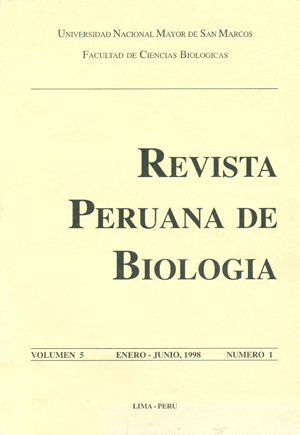Native strains of the marine bacterioneuston and inhibitory activity of ichthyopathogenic bacteria
DOI:
https://doi.org/10.15381/rpb.v5i1.8320Keywords:
antagonism, bacterioneuston, ichthiopathogens, aquaculture, antibiosis, marine bacteria.Abstract
Marine bacteria have been frequently included in the scientific literature as producers substance antibacterial properties. In this study, we investigate the potential activity antibiotic in vitro of strains the marine bacterioneuston isolated from rocky litoral pools in Montemar Beach, Bay of Valparaiso, Chile. Were isolated 71 strains antagonic to Staphylococcus aureus ATCC 11632. Twentyfive strains producing strongly inhibitory substance were tested against 15 know ichthiopathogenic bacteria. Applying a classic method for marine bacteria, they were carried out phenotypic characterization of bacterioneuston strains accordingly to identified. Results showed that all fifteen ichthiopathogens strains were inhibeted by the neustonic isolates, being V anguillarum NCMB 2133, V ordalii 84/2559 and V tubiashii EX1 the most sensitive. Strains of bacterioneuston were identified as Vibrio spp. (28%), Flavobacterium spp. (12%), AlteromonasMarinomonas group (12%), Pseudomonas spp. (8%) and Micrococcus spp. (4%). Nine neustonic isolates did not match our identifications schemes. Experimental results suggest that this strains or their products coullo be useful in activities of intensive cultivation of aquaculture fish, mollusks and crustaceans.Downloads
Downloads
Published
Issue
Section
License
Copyright (c) 1998 Jorge León, Patrico Gracía-Tello

This work is licensed under a Creative Commons Attribution-NonCommercial-ShareAlike 4.0 International License.
AUTHORS RETAIN THEIR RIGHTS:
a. Authors retain their trade mark rights and patent, and also on any process or procedure described in the article.
b. Authors retain their right to share, copy, distribute, perform and publicly communicate their article (eg, to place their article in an institutional repository or publish it in a book), with an acknowledgment of its initial publication in the Revista Peruana de Biologia.
c. Authors retain theirs right to make a subsequent publication of their work, to use the article or any part thereof (eg a compilation of his papers, lecture notes, thesis, or a book), always indicating its initial publication in the Revista Peruana de Biologia (the originator of the work, journal, volume, number and date).


















